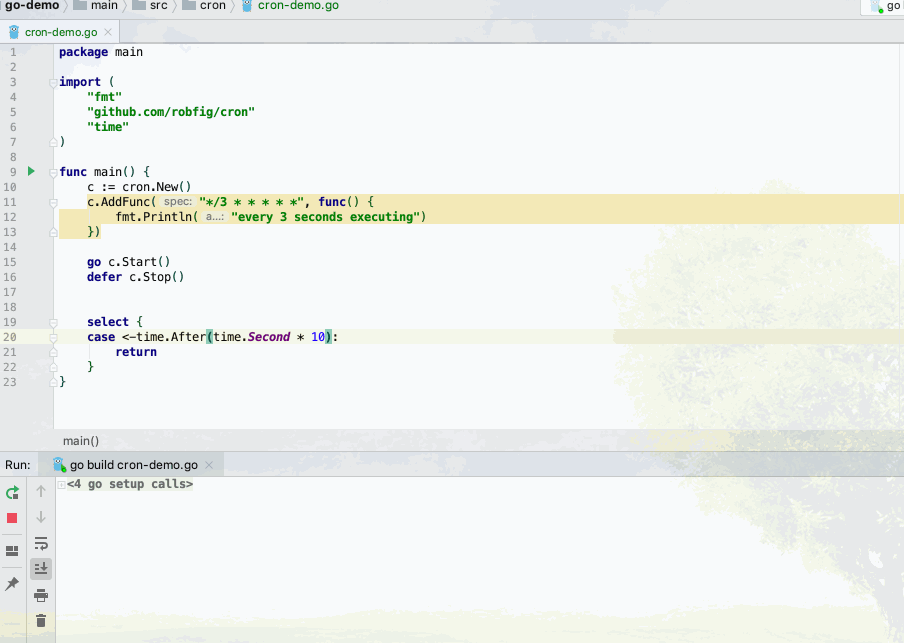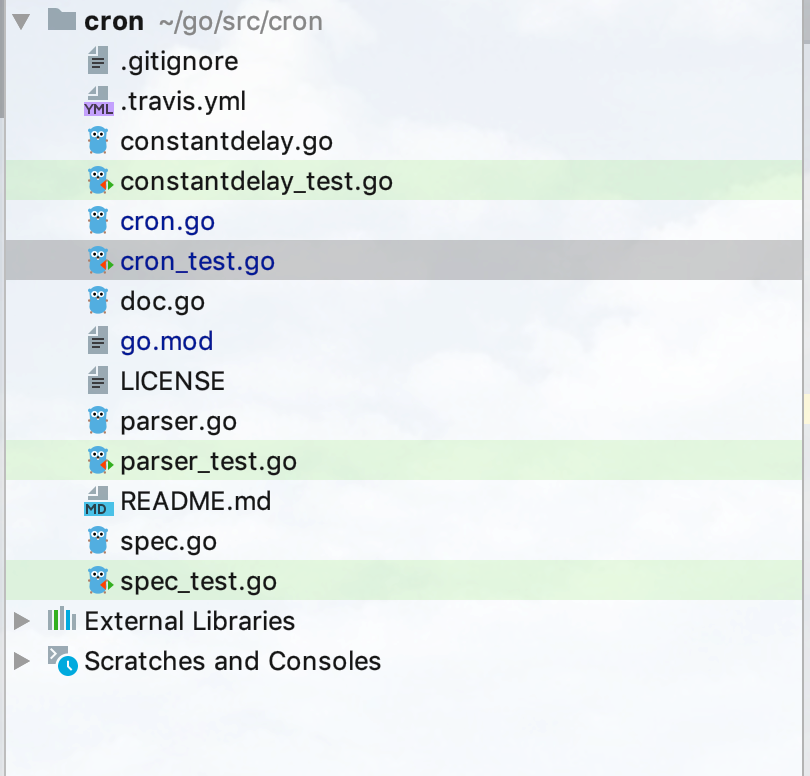1 前言
转到Go已经将近三个月,写业务代码又找到了属于Go的条件反射了。
后置声明和多参数返回这些Go风格代码写起来也不会那么蹩脚,甚至还有点小适应~
反而,前几天在写Java的时候,发现Java怎么启动这么慢,Java怎么能够容忍这些用不到的代码还理直气壮的躺在那……等等,这些话在哪听过类似的???
“Go为什么要后置声明,多别扭啊”
“Go里面为啥要定义这么多的struct,看的头晕”
……
其实,没有最好的语言,只有最适合的。
前面《Go语言学习》系列主要介绍了一些Go的基础知识和相较于Java的一些新特性。后续如果有相关的体会和新的还会继续更新。
从这篇开始,开始学习Go的一些工具类库和开源组件,希望在学习这些优秀的开源项目过程中,更深入的了解Go,发现Go的威力。
2 cron简介
robfig/cron是一个第三方开源的任务调度库,也就是我们平时说的定时任务。
Github:https://github.com/robfig/cron
官方文档:https://godoc.org/github.com/robfig/cron
3 cron如何使用
1、新建文件cron-demo.go
package main
import (
"fmt"
"github.com/robfig/cron"
"time"
)
func main() {
c := cron.New()
c.AddFunc("*/3 * * * * *", func() {
fmt.Println("every 3 seconds executing")
})
go c.Start()
defer c.Stop()
select {
case <-time.After(time.Second * 10):
return
}
}
-
cron.New创建一个定时器管理器
-
c.AddFunc添加一个定时任务,第一个参数是cron时间表达式,第二个参数是要触发执行的函数
-
go c.Start()新启一个协程,运行定时任务
-
c.Stop是等待停止信号结束任务
2、在cron-demo.go文件下执行go build
本项目采用go mod进行包管理,所以执行go build命令后,会在go.mod文件中生成对应的依赖版本如图所示

3、运行cron-demo.go

可以看出每3秒执行一次,直到10秒后过期退出进程,任务结束。
代码参见项目:go-demo项目(https://github.com/DMinerJackie/go-demo/tree/master/main/src/cron)
看上去这个任务调度还是蛮好用的,那么具体是如何实现的呢,看了下源码,也是非常的短小精悍,目录结构如下。

下面通过几个问题一起看下cron是如何实现任务调度。
4 cron如何解析任务表达式
上例我们看到添加“*/3 * * * * *”这样的表达式,就能实现每3秒执行一次。
显然,这个表达式只是对人友好的一种约定表达形式,要真正在指定时间执行任务,cron肯定是要读取并解析这个c表达式,转化为具体的时间再执行。
那我们来看看,这个具体是如何执行的。
进入AddFunc函数实现
// AddFunc adds a func to the Cron to be run on the given schedule.
func (c *Cron) AddFunc(spec string, cmd func()) error {
return c.AddJob(spec, FuncJob(cmd))
}
这只是套了个壳,具体还要进入AddJob函数
// AddJob adds a Job to the Cron to be run on the given schedule.
func (c *Cron) AddJob(spec string, cmd Job) error {
schedule, err := Parse(spec)
if err != nil {
return err
}
c.Schedule(schedule, cmd)
return nil
}
该函数第一行就是解析cron表达式,顺藤摸瓜,我们看到具体实现如下
// Parse returns a new crontab schedule representing the given spec.
// It returns a descriptive error if the spec is not valid.
// It accepts crontab specs and features configured by NewParser.
func (p Parser) Parse(spec string) (Schedule, error) {
if len(spec) == 0 {
return nil, fmt.Errorf("Empty spec string")
}
if spec[0] == '@' && p.options&Descriptor > 0 {
return parseDescriptor(spec)
}
// Figure out how many fields we need
max := 0
for _, place := range places {
if p.options&place > 0 {
max++
}
}
min := max - p.optionals
// Split fields on whitespace
fields := strings.Fields(spec) // 使用空白符拆分cron表达式
// Validate number of fields
if count := len(fields); count < min || count > max {
if min == max {
return nil, fmt.Errorf("Expected exactly %d fields, found %d: %s", min, count, spec)
}
return nil, fmt.Errorf("Expected %d to %d fields, found %d: %s", min, max, count, spec)
}
// Fill in missing fields
fields = expandFields(fields, p.options)
var err error
field := func(field string, r bounds) uint64 { // 抽象出filed函数,方便下面调用
if err != nil {
return 0
}
var bits uint64
bits, err = getField(field, r)
return bits
}
var (
second = field(fields[0], seconds)
minute = field(fields[1], minutes)
hour = field(fields[2], hours)
dayofmonth = field(fields[3], dom)
month = field(fields[4], months)
dayofweek = field(fields[5], dow)
)
if err != nil {
return nil, err
}
return &SpecSchedule{
Second: second,
Minute: minute,
Hour: hour,
Dom: dayofmonth,
Month: month,
Dow: dayofweek,
}, nil
}
该函数主要是将cron表达式映射为“Second, Minute, Hour, Dom, Month, Dow”6个时间维度的结构体SpecSchedule。
SpecSchedule是实现了方法“Next(time.Time) time.Time”的结构体,而“Next(time.Time) time.Time”是定义在Schedule接口中的
// The Schedule describes a job's duty cycle.
type Schedule interface {
// Return the next activation time, later than the given time.
// Next is invoked initially, and then each time the job is run.
Next(time.Time) time.Time
}
所以,最终可以理解是将cron解析后转换为下一次要执行的时刻,等待执行。
5 cron如何执行任务
我们知道通过parser.go可以将人很好理解的表达式转换为cron可以读懂的要执行的时间。
有了要执行的时间点,那么cron具体是如何执行这些任务的呢?
我们看下Start函数的具体实现
// Start the cron scheduler in its own go-routine, or no-op if already started.
func (c *Cron) Start() {
if c.running {
return
}
c.running = true
go c.run()
}
这里会通过判定Cron的running字段是否在运行来巨额听是否要启动任务。
显然这里running是false,因为在调用c.New初始化的时候running被设置为false。
所以,这里新启一个协程用于执行定时任务,再次顺藤摸瓜,我们看到run函数的实现
// Run the scheduler. this is private just due to the need to synchronize
// access to the 'running' state variable.
func (c *Cron) run() {
// Figure out the next activation times for each entry.
now := c.now()
for _, entry := range c.entries {
entry.Next = entry.Schedule.Next(now)
}
for {
// Determine the next entry to run.
sort.Sort(byTime(c.entries))
var timer *time.Timer
if len(c.entries) == 0 || c.entries[0].Next.IsZero() { // 如果没有要执行的任务或者第一个任务的待执行时间为空,则睡眠
// If there are no entries yet, just sleep - it still handles new entries
// and stop requests.
timer = time.NewTimer(100000 * time.Hour)
} else {
timer = time.NewTimer(c.entries[0].Next.Sub(now)) // 否则新建一个距离现在到下一个要触发执行的Timer
}
for {
select {
case now = <-timer.C: // 触发时间到,执行任务
now = now.In(c.location)
// Run every entry whose next time was less than now
for _, e := range c.entries {
if e.Next.After(now) || e.Next.IsZero() {
break
}
go c.runWithRecovery(e.Job)
e.Prev = e.Next
e.Next = e.Schedule.Next(now)
}
case newEntry := <-c.add: // 添加任务
timer.Stop()
now = c.now()
newEntry.Next = newEntry.Schedule.Next(now)
c.entries = append(c.entries, newEntry)
case <-c.snapshot: // 调用c.Entries()返回一个现有任务列表的snapshot
c.snapshot <- c.entrySnapshot()
continue
case <-c.stop: // 任务结束,退出
timer.Stop()
return
}
break
}
}
}
-
进入该函数,首先遍历所以任务,找到所有任务下一个要执行的时间。
-
然后进入外层for循环,对于各个任务按照执行时间进行排序,保证离当前时间最近的先执行。
-
再对任务列表进行判定,是否有任务如果没有,则休眠,否则初始化一个timer。
里层的for循环才是重头戏,下面主要分析这个for循环里面的任务加入和执行。
在此之前,需要了解下go标准库的timer
timer用于指定在某个时间间隔后,调用函数或者表达式。
使用NewTimer就可以创建一个Timer,在指定时间间隔到达后,可以通过<-timer.C接收值。
package main
import (
"fmt"
"time"
)
func main() {
timer1 := time.NewTimer(2 * time.Second)
<-timer1.C
fmt.Println("Timer 1 expired")
timer2 := time.NewTimer(time.Second)
go func() {
<-timer2.C
fmt.Println("Timer 2 expired")
}()
stop2 := timer2.Stop()
if stop2 {
fmt.Println("Timer 2 stopped")
}
}
执行结果为
Timer 1 expired Timer 2 stopped
timer1表示2秒后到期,在此之前都是阻塞状态,2秒后<-timer1.C接收到信号,执行下面的打印语句。
timer2表示1秒后到期,但是中途被Stop掉了,相当于清除了定时功能。
有了这个背景之后,我们再来看run函数的里层for循环。
接收到c.add信道
case newEntry := <-c.add: // 添加任务 timer.Stop() now = c.now() newEntry.Next = newEntry.Schedule.Next(now) c.entries = append(c.entries, newEntry)
将timer停掉,清除设置的定时功能,并以当前时间点为起点,设置添加任务的下一次执行时间,并添加到entries任务队列中。
接收到timer.C信道
case now = <-timer.C: // 触发时间到,执行任务
now = now.In(c.location)
// Run every entry whose next time was less than now
for _, e := range c.entries {
if e.Next.After(now) || e.Next.IsZero() {
break
}
go c.runWithRecovery(e.Job)
e.Prev = e.Next
e.Next = e.Schedule.Next(now)
}
当定任务到点后,time.C就会接收到值,并新开协程执行真正需要执行的Job,之后再更新下一个要执行的任务列表。
我们进入runWithRecovery函数,该函数从函数名就可以看出,即使出现panic也可以重新recovery,保证其他任务不受影响。
func (c *Cron) runWithRecovery(j Job) {
defer func() {
if r := recover(); r != nil {
const size = 64 << 10
buf := make([]byte, size)
buf = buf[:runtime.Stack(buf, false)]
c.logf("cron: panic running job: %v
%s", r, buf)
}
}()
j.Run()
}
追根溯源,我们发现真正执行Job的是j.Run()的执行。进入这个Run函数的实现,我们看到
func (f FuncJob) Run() { f() }
没错,我们要执行的任务一直从AddFunc一直往下传递,直到这里,我们通过调用Run函数,将包装的FuncJob类型的函数通过f()的形式进行执行。
这里说的可能比较模糊,举个例子,Go里面的闭包定义
func () {
fmt.Println("test")
}()
如果这里定义后面没有"()"该函数就不会执行,所以结合这个看上面的定时任务是如何执行就更容易理解了。
6 代码阅读体会
1、channel的奥妙
通过channel可以让感知变得轻而易举,比如timer.C就像是时间到了,自然会有人来敲门告诉你。而不需要我们自己主动去获取是否到期了。
2、常用类库的使用
比如在parser里面我们看到了"fields := strings.Fields(spec)",在日常开发中,我们可以灵活使用这些API,避免自己造轮子的情况。
3、多思考
之前做Java的时候,更多的是沉浸在各种工具和框架的使用,对于这些工具和框架的实现关注的不多。比如从Quartz到Spring Job,我们需要更新的是越来越好用的定时任务工具,而底层的实现升级Spring都帮我们考虑好了。这种对业务对项目有友好的,可以快速的实现业务功能开发,但是对于开发者并不友好,友好的设计麻痹了开发者对于底层原理的深究的欲望。